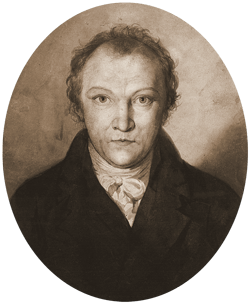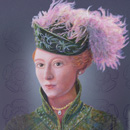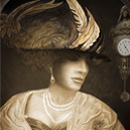A creature ferocious but not entirely bad
Transcript
Tyger Tyger, burning bright,
In the forests of the night;
What immortal hand or eye,
Could frame thy fearful symmetry?
In what distant deeps or skies.
Burnt the fire of thine eyes?
On what wings dare he aspire?
What the hand, dare seize the fire?
And what shoulder, & what art,
Could twist the sinews of thy heart?
And when thy heart began to beat,
What dread hand? & what dread feet?
What the hammer? what the chain,
In what furnace was thy brain?
What the anvil? what dread grasp,
Dare its deadly terrors clasp!
When the stars threw down their spears
And water'd heaven with their tears:
Did he smile his work to see?
Did he who made the Lamb make thee?
Tyger Tyger burning bright,
In the forests of the night:
What immortal hand or eye,
Dare frame thy fearful symmetry?
In the forests of the night;
What immortal hand or eye,
Could frame thy fearful symmetry?
In what distant deeps or skies.
Burnt the fire of thine eyes?
On what wings dare he aspire?
What the hand, dare seize the fire?
And what shoulder, & what art,
Could twist the sinews of thy heart?
And when thy heart began to beat,
What dread hand? & what dread feet?
What the hammer? what the chain,
In what furnace was thy brain?
What the anvil? what dread grasp,
Dare its deadly terrors clasp!
When the stars threw down their spears
And water'd heaven with their tears:
Did he smile his work to see?
Did he who made the Lamb make thee?
Tyger Tyger burning bright,
In the forests of the night:
What immortal hand or eye,
Dare frame thy fearful symmetry?
Insights, themes and ideas for interpretation
● The poem is to be found in a collection entitled ‘Songs of Innocence and Experience’ published in 1794 and should probably be considered alongside another piece written a little earlier called ‘The Lamb,’ thereby contrasting the savage and wild with the meek and mild. But why?
● In this short poem about the life force, the poet contemplates things that are scary and ferocious – a tiger, something burning in the dark forest. These are encapsulated in the notion of The Tyger, a kind of uber-beast. Could such a thing be the work of a loving God? Surely not. Not the same God as made the Lamb! How could the Maker produce all the attractive and acceptable things in life, but at the same time create all those things that are ferocious or wicked?
● With an obvious use of repetition and alliteration it is a poem that deliberately breaks the rules - rather like the Tyger itself, which cannot be ‘framed’ – that is, contained. Nor is the Tyger, Blake reminds us, anything that can be constructed in a furnace or hammered out on an anvil. It is beyond the reach of our rational analytical brain.
● We are invited, however, to come to the conclusion that the Tyger is not evil simply because of this unconformity, or because he might wish to eat us for supper. Nor does the Tyger consider himself to be evil.
● The Tyger embodies both beauty and bestiality, grace and indomitable strength. Attributing nice things to God and bad to the Devil is easy enough, but the inference here - in the best mystical tradition - is that both are worthy. Both are aspects of the same life-force in all its glorious contradictions and mysteries.
● Blake had his own unique vision of the world of the spirit, and believed in the synthesis of opposites, that all things that are of light or dark, or good or evil were ultimately from the same source. It is possible for us to admire the Tyger spiritually, therefore, as well as fear it physically - since it, too, is an aspect of the Divine.
● In this short poem about the life force, the poet contemplates things that are scary and ferocious – a tiger, something burning in the dark forest. These are encapsulated in the notion of The Tyger, a kind of uber-beast. Could such a thing be the work of a loving God? Surely not. Not the same God as made the Lamb! How could the Maker produce all the attractive and acceptable things in life, but at the same time create all those things that are ferocious or wicked?
● With an obvious use of repetition and alliteration it is a poem that deliberately breaks the rules - rather like the Tyger itself, which cannot be ‘framed’ – that is, contained. Nor is the Tyger, Blake reminds us, anything that can be constructed in a furnace or hammered out on an anvil. It is beyond the reach of our rational analytical brain.
● We are invited, however, to come to the conclusion that the Tyger is not evil simply because of this unconformity, or because he might wish to eat us for supper. Nor does the Tyger consider himself to be evil.
● The Tyger embodies both beauty and bestiality, grace and indomitable strength. Attributing nice things to God and bad to the Devil is easy enough, but the inference here - in the best mystical tradition - is that both are worthy. Both are aspects of the same life-force in all its glorious contradictions and mysteries.
● Blake had his own unique vision of the world of the spirit, and believed in the synthesis of opposites, that all things that are of light or dark, or good or evil were ultimately from the same source. It is possible for us to admire the Tyger spiritually, therefore, as well as fear it physically - since it, too, is an aspect of the Divine.

Blake (possibly a self-portrait)
Technical info’
Type of Poem =
a 'rhetorical' poem of six stanzas, each one being made up of rhyming couplets of four lines (quatrains).
Rhyme Scheme =
AABBMeter =
variable, but containing lines of trochaic tetrameter blended with iambic tetrameter - that is, lines of four stressed and unstressed syllables or, alternatively, pairs of unstressed and stressed syllables. However, the final syllable is often dropped altogether.Georgian novel
Historical Novel
Neo-Victorian
Historical Novel













